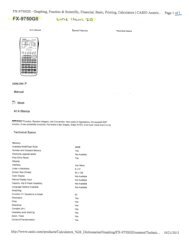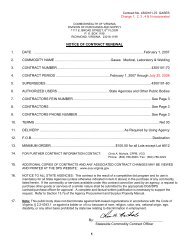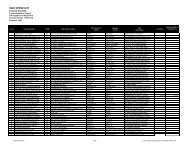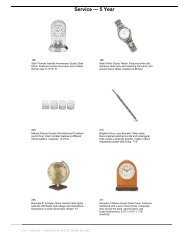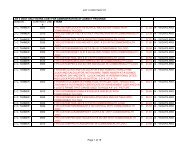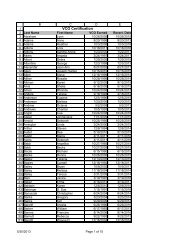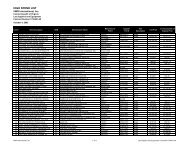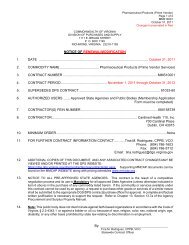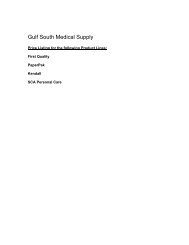attachment 2 section i ? technical specifications commuter coach ...
attachment 2 section i ? technical specifications commuter coach ...
attachment 2 section i ? technical specifications commuter coach ...
Create successful ePaper yourself
Turn your PDF publications into a flip-book with our unique Google optimized e-Paper software.
Page 17<br />
ATTACHMENT 2<br />
bumper when fully opened. All door glazing shall be ¼ inch laminated safety-glass tinted the same as<br />
the windshield and indelibly marked AS-2 Door glazing shall make up 65% of the surface area of the<br />
door. No entrance door key lock shall be provided.<br />
2.8.14 SERVICE COMPARTMENTS AND ACCESS DOORS<br />
2.8.14.1 INTERIOR<br />
Access for maintenance and replacement of equipment shall be provided by panels and doors that<br />
appear to be an integral part of the interior. Removal of fixtures or equipment unrelated to the repair<br />
task to gain access shall be minimized. Access doors, if hinged, shall be hinged with props, as<br />
necessary, to hold the doors up and out of the mechanic's way with the exception of the destination sign<br />
box door which hinges down and is held by chains in the open position. Panel fasteners shall be<br />
standardized so that only two tools are required to service all special fasteners within the <strong>coach</strong>. These<br />
fasteners shall be captive in the panel except for the engine compartment access hatches. Access doors<br />
for the door actuator compartments shall be secured with hand screws or latches, and shall be sealed to<br />
prevent entry of mechanism lubricant into the <strong>coach</strong> interior. All hinges and props must be designed to<br />
preclude accidental closure when the panels are opened.<br />
2.8.14.2 EXTERIOR<br />
Vertically hinged doors shall be used for the engine compartment and for all auxiliary equipment<br />
compartments including doors for checking the quantity and adding to the engine coolant, engine<br />
lubricant, transmission fluid and the windshield washer reservoir. The upper engine radiator/C.A.C.<br />
compartment door may be horizontally hinged. Access to these compartments shall be from outside the<br />
<strong>coach</strong>. Access openings shall be sized for easy performance of tasks within the compartment including<br />
tool operating space. Access doors shall be of rugged construction and shall be capable of withstanding<br />
severe abuse throughout the life of the <strong>coach</strong>. They shall close flush with the body surface. All doors<br />
shall be hinged at the top or on the forward edge and shall be prevented from coming loose or opening<br />
during transit service or in <strong>coach</strong> washing operations. Doors with top hinges shall have safety props<br />
stored behind the door or on the door frame. All access doors (except vertically hinged access doors)<br />
shall be sufficiently retained in the open position by props or counterbalancing. Gas springs shall only<br />
be permitted on the rear upper engine cooling door. Springs and hinges shall be corrosion-resistant and<br />
shall last throughout the service life of the <strong>coach</strong>. Latch handles shall be sized to provide an adequate<br />
grip for opening. Large access doors shall hinge up and out of the way or fold flat against the <strong>coach</strong><br />
body and shall be easily operable by one person. These doors, when opened, shall not restrict access<br />
for servicing other components or systems. Retention devices utilized to hold the engine compartment<br />
access doors in the open position shall be heavy duty and designed to last the service life of the <strong>coach</strong>.<br />
No locks shall be supplied on the battery door or the master switch access door.<br />
2.9 OPERATING COMPONENTS<br />
2.9.1 DOORS<br />
2.9.1.1 CONTROL



